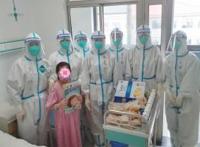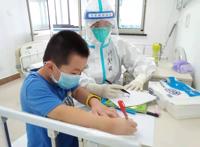《抗击新冠肺炎疫情的中国行动》白皮书(双语全文)(89)
2023-06-03 来源:旧番剧
大力加强医疗物资生产供应和医疗支持服务。疫情防控阻击战,也是后勤保障战。疫情初期,武汉市医疗防护物资极度短缺,为了节省防护用品、争分夺秒抢救病患,一线医护人员克服困难,最大限度地延长防护用品使用时间。为尽快解决医疗资源短缺和病患急剧增多的突出矛盾,中国充分发挥制造业门类全、韧性强和产业链完整配套的优势,克服春节假期停工减产等不利因素,开足马力,深挖潜力,全力保障上下游原料供应和物流运输,保证疫情防控物资的大规模生产与配送。医疗企业克服工人返岗不足等困难,以最快速度恢复医疗用品生产,最大限度扩大产能。其他行业企业迅速调整转产,生产口罩、防护服、消毒液、测温仪等防疫物资,有效扩大了疫情防控物资的生产供应。快速启动防控医疗物资应急审批程序,全面加强质量安全监管,确保以最快的速度批准上市、促产保供,截至5月31日,共应急批准17个药物和疫苗的19件临床试验申请,附条件批准2个疫情防控用药上市。在各方共同努力下,医用物资产能不断提升,医用物资保供实现从“紧缺”到“紧平衡”“动态平衡”“动态足额供应”的跨越式提升(表2)。2月初,医用非N95口罩、医用N95口罩日产量分别为586万只、13万只,到4月底分别超过2亿只、500万只。畅通供应链条和物流渠道,建立联保联供协作机制,源源不断地把全国支援物资运送到疫情防控重点地区。Increasing the production and supply of medical supplies and medical support services.Victory in the battle against Covid-19 depends on logistical support. In view of the extreme scarcity of medical protective materials in Wuhan during the early stage of the epidemic, medical workers on the front line overcame difficulties and used every item for the longest possible time, so as to conserve them in the race to save lives. To address the shortfall in medical resources while patient numbers surged, China exploited the full strength of its comprehensive and resilient manufacturing sector and its complete industrial chain.To overcome the unfavorable combination of a pause in work and the resultant decline in manufacturing output during the Chinese New Year holiday, the Chinese government mobilized factories across the country to operate at full capacity and tap into their full potential. With all its strength, it supported raw materials supplies and transport facilities throughout the industrial chain, so as to ensure large-scale production and distribution of materials for epidemic prevention and control. Medical manufacturers overcame such difficulties as labor shortages caused by workers not having returned to their posts. They resumed production as quickly as possible, and expanded capacity to the maximum.Enterprises in other industries made rapid adjustments to their manufacturing facilities and turned to producing masks, protective suits, disinfectants, temperature measuring devices, and other products for the fight against the epidemic, thereby effectively expanding the overall output of such materials and equipment. The Chinese government quickly started procedures to review applications for producing medical supplies in times of emergency, and imposed stricter quality and safety supervision across the board, so as to facilitate production, ensure the quickest approval for sale, and guarantee supplies.As of May 31, relevant authorities had approved 19 applications for clinical trials of 17 medicines and vaccines for coronavirus prevention and control, and conditionally approved the applications for sale of two medicines. Thanks to the joint efforts of many parties, manufacturing capacity for medical supplies increased steadily, and efforts to ensure the supply of medical materials and equipment achieved rapid progress: from acute shortage to borderline sufficiency, then from demand-supply balance to timely and sufficient supplies (see Table 2). The daily output of medical N95 masks and medical non-N95 masks increased from 130,000 and 5.86 million in early February to over 5 million and 200 million by the end of April. These efforts opened up unimpeded supply chains and logistics channels, gave birth to a coordination mechanism ensuring material supply, and allowed continuous transport of materials from across the country to the hardest-hit areas.
猜你喜欢
动漫推荐
免责声明:动漫番剧数据来源网络!本站不收费,无vip,请勿上当!
www.jiufanju.com-旧番剧


























